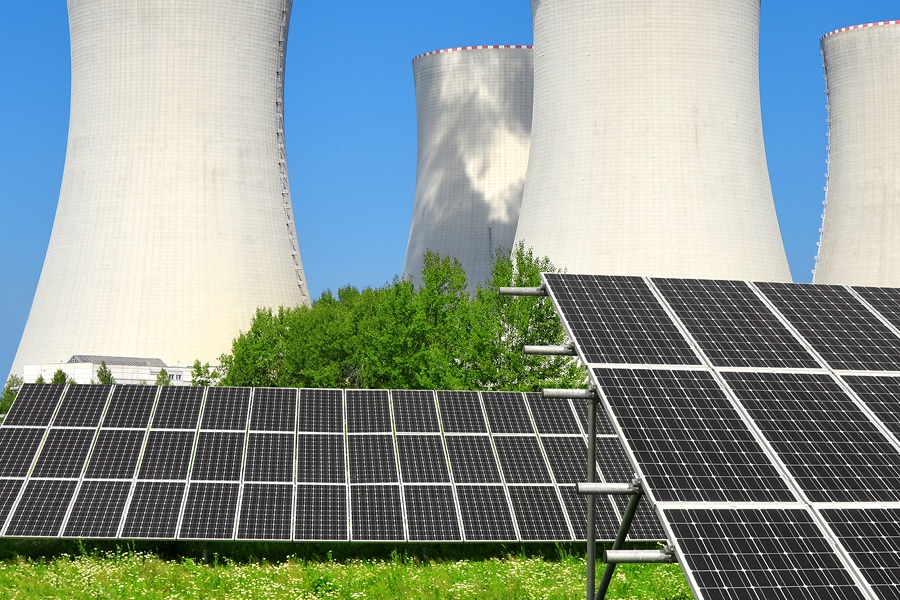Apr 26 2018
 Power plants that balance nuclear and renewable energy could increase revenues from electricity markets and reduce variable operating and maintenance costs, according to Argonne scientists. (Credit: Shutterstock/Vaclav Volrab and Argonne National Laboratory)
Power plants that balance nuclear and renewable energy could increase revenues from electricity markets and reduce variable operating and maintenance costs, according to Argonne scientists. (Credit: Shutterstock/Vaclav Volrab and Argonne National Laboratory)
Typically, nuclear power plants are either operated to their full potential or not operated at all. However, the technical ability of the plants enables them to adapt to the varying demand for power, thereby better accommodating renewable energy sources such as solar power or wind.
Recently, scientists from the U.S. Department of Energy’s (DOE) Argonne National Laboratory and the Massachusetts Institute of Technology investigated the advantages of implementing this. The view of the scientists is that if nuclear plants produced power in a more flexible way, the electricity costs for consumers could be reduced, more renewable energy could be used, the economics of nuclear energy could be improved, and greenhouse gas emissions can be reduced.
The researchers investigated the technical difficulties in achieving flexible operations at nuclear power plants and presented an innovative method for modeling the effect of these challenges in the way the power systems operate. “Flexible nuclear power operations are a ‘win-win-win,’ lowering power system operating costs, increasing revenues for nuclear plant owners and significantly reducing curtailment of renewable energy,” the researchers described in an article published online in the Applied Energy journal on April 24, 2018.
This research evaluates and demonstrates the potential value of flexible nuclear operations in a realistic power system in the United States challenged by high variability in renewable-energy generation.
Audun Botterud, Principal Energy Systems Engineer, Energy Systems Division, Argonne
The research helps in dismissing long-held opinions that nuclear power plants should run in “baseload” mode, generating power at maximum rated capacity every time they are online. The researchers discovered that nuclear plants also have the capacity to dynamically respond to second-to-second frequency regulation needs and hourly electricity market prices. Power systems incorporating renewable energy have to be highly flexible to be able to constantly balance between demand and supply. Although nuclear operators in France, Germany, and other countries have knowledge on this strategy, those in the United States are less familiar.
A mathematical representation of the physics-induced operational constraints emerging at the time of the fuel irradiation cycle and due to nuclear reactor dynamics has been developed by the team and reported in the Applied Energy article as well as a companion paper, published in Nuclear Technology. Then, the multidisciplinary group integrated the innovative method with power system simulation models to estimate the overall cost of electricity generation, market prices, and ensuing revenues for power plants, presuming distinctive levels of nuclear flexibility.
Nuclear power plants are governed by a different set of principles compared to other generators, and our approach enables the representation of these relationships in the analysis of power systems and electricity markets.
Francesco Ganda, Principal Nuclear Engineer, Nuclear Science and Engineering Division, Argonne
Ensuring flexibility would allow the plant operators to minimize the overall operating costs of the power system. For instance, operators can reduce the production of nuclear power if renewable energy is abundantly available. Hence, nuclear plants can take advantage of their extra capacity to sell valuable “operating reserves,” or the potential to rapidly change power output to assist grid operators in rebalancing demand and supply in case of unanticipated events, such as errors in demand forecasts or power plant failures.
By being flexible, the profitability of nuclear plants could be increased by boosting revenues generated by electricity markets and by minimizing variable maintenance and operating costs. In general, the flexibility of nuclear plants can also support the incorporation of more solar and wind resources and decrease energy generation from fossil fuels and associated greenhouse gas emissions.
Gives us tools to further explore potential benefits of flexible nuclear operations to work in tandem with greater shares of variable sources of renewable power generation on the pathway towards low-carbon electricity supply.
Jesse Jenkins, Graduate Researcher, MIT Energy Initiative
Richard Vilim, Zhi Zhou, and Roberto Ponciroli are the other authors of the Argonne study. The study was partially funded by Argonne’s Laboratory Directed Research and Development program.